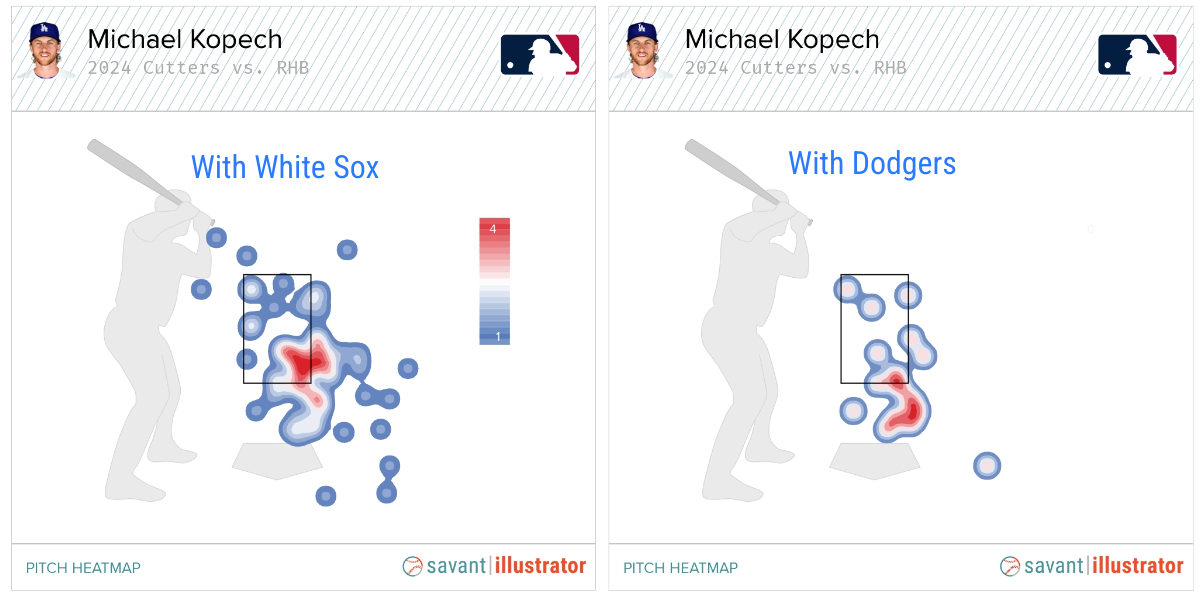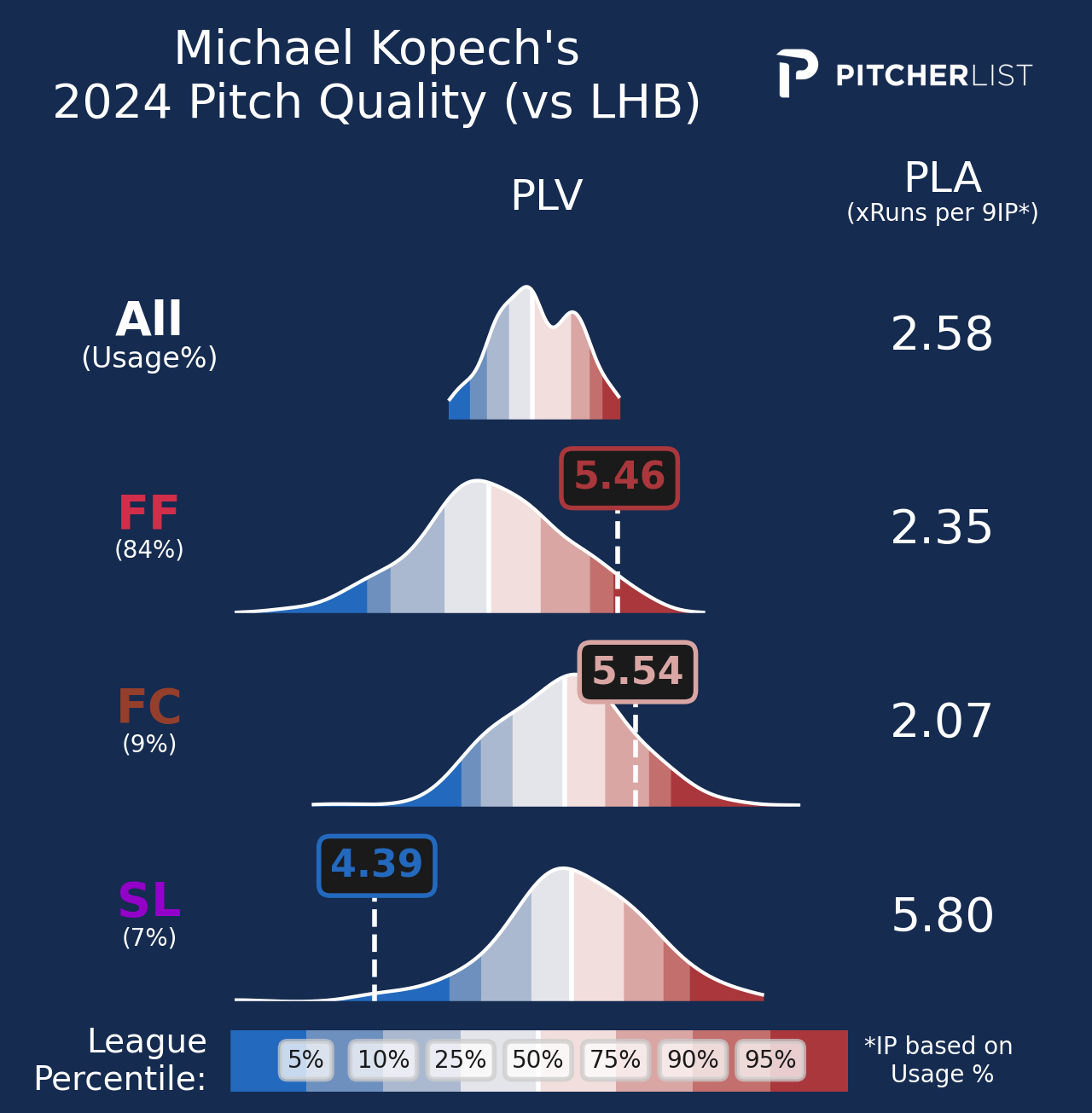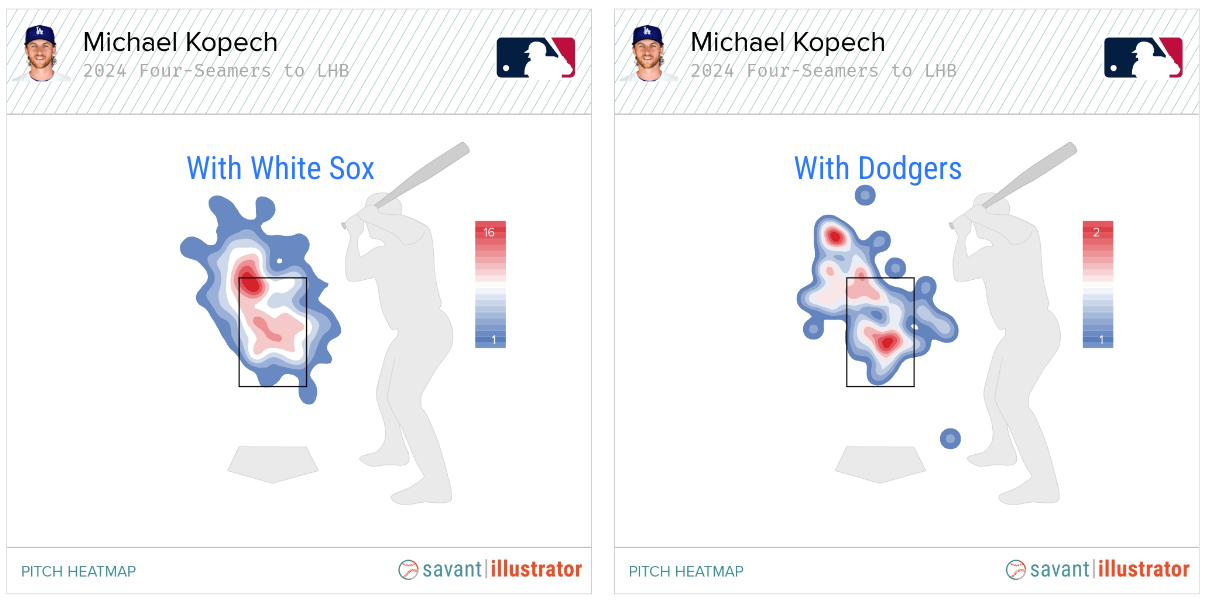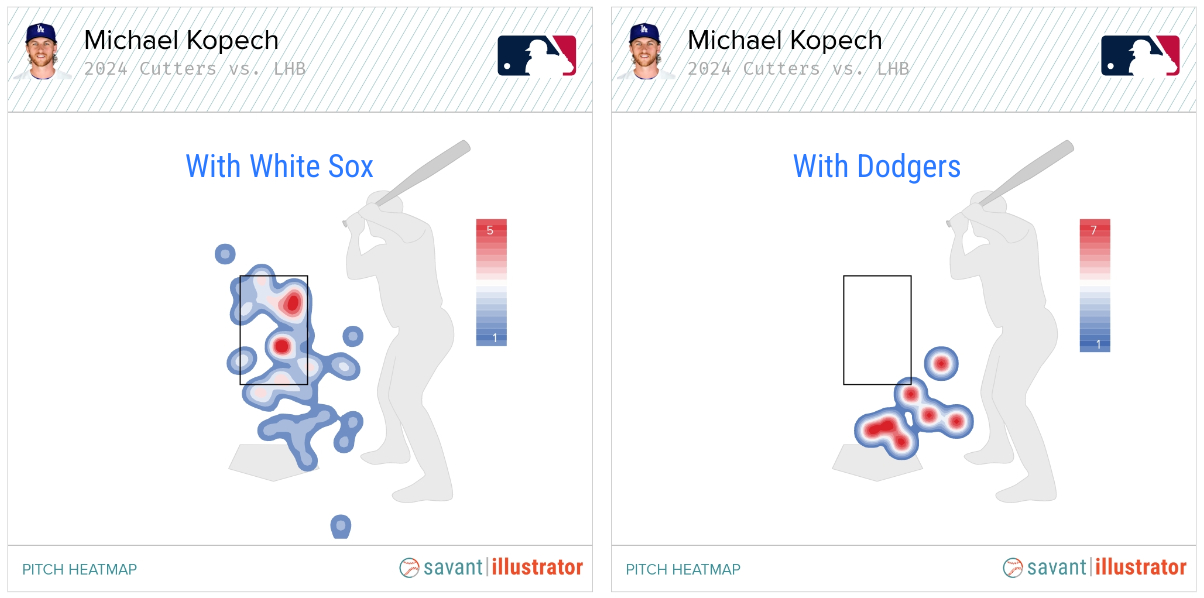We probably should have seen this coming. Maybe you did. When the Dodgers acquired hard-throwing right-hander Michael Kopech at the trade deadline from the lowly White Sox, one of the least surprising potential outcomes was that they would offer him a handful of simple tweaks that would unleash his full potential, seemingly overnight, just as they had before with pitchers like Ryan Brasier, Alex Wood, Evan Phillips, Tyler Anderson, Phil Bickford, and others.
Since joining the cast in Hollywood, Kopech has run off a string of nine straight scoreless outings in dominant fashion and quickly ascended to the top of their bullpen hierarchy, notching saves in his last two appearances.
Michael Kopech’s 2Ks in the 9th. pic.twitter.com/mDCAUM71de
— Rob Friedman (@PitchingNinja) August 17, 2024
So, here we are again. The Dodgers have taken someone else’s underperforming player, applied some quick fixes, and created a late-inning weapon for the stretch run and beyond.
Let’s dig into the changes Kopech has implemented.
Kopech’s Road to Hollywood
Inarguably, none of the prior L.A. reclamation projects had the raw talent and untapped potential of Kopech. Kopech has always been tantalizing as a former first-round draft pick with a build straight out of central casting for a starting pitcher. That potential was hyped, perhaps to an unrealistic degree, thanks to Paul Bunyan-esque tales of a fastball that touched 105 in the minors. But finding sustained success at the game’s highest level proved to be a challenge. Shaky performance, injuries, and workload management concerns showed that Kopech was yo-yoed back and forth between the White Sox rotation and bullpen.
He was a staple on top prospect lists from 2016 through 2021, peaking as a consensus global top 15 prospect before the 2018 season, a year after he was one of the headliners of the trade that sent left-hander Chris Sale to the Red Sox.
Kopech made his MLB debut with four starts late in the 2018 season, but his initial cup of coffee was cut short by an elbow injury that required Tommy John surgery. That cost him 2019 and Kopech opted out of the 2020 pandemic season.
In 2021, he pitched effectively (3.50 ERA, 2.97 FIP, 1.7fWAR), primarily as a reliever. The next year he was a staple in the South Siders’ rotation, making 25 starts with a nifty, albeit misleading 3.54 ERA. Under the hood of that were signs of trouble, including an elevated 11.5% walk rate and an unimpressive 21.3% strikeout that belied his raw stuff.
Those warning signs played out in a big way last season when Kopech’s ERA jumped to 5.43 across 27 starts and 30 total appearances. His FIP was an even worse 6.46 thanks to a walk rate that ballooned to 15.3% and 2.02 home runs allowed per 9 innings. Among the 117 starting pitchers to throw at least 100 innings last season, Kopech’s FIP and -0.9 fWAR ranked dead last.
So, back to the bullpen he went this season, this time in a leverage role that had less to do with his prior work and more to do with the lack of better options on the White Sox talent-limited roster. In 43 games with Chicago this season, Kopech worked to a 4.74 ERA with a 4.85 FIP to match. His strikeouts ticked back up to 30.9% in relief, and he corralled his walks to a slightly better, but still pretty terrifying 12.6%. He saved 9 games for Chicago, but also had 5 blown saves and 11 appearances that qualified as “meltdowns.”
That was the context when the Dodgers sought to add Kopech to their bullpen in a complex three-team trade that also netted them Tommy Edman from St. Louis.
Stuff To Work With
Despite Kopech’s poor results, it isn’t difficult to see why the Dodgers were interested. Along with the favorable prospect pedigree, he was among the game’s very hardest throwers, with a four-seamer that averaged 98.8 mph (99th percentile), generated a very healthy 33.3% CSW%, and graded out in the same neighborhood as Tyler Glasnow and Mason Miller by PLV this season.
In addition to the prominent heater, Kopech mixed in about 10% cutters and 10% sliders. The cutter was a new weapon added this season in part, because his slider, and the changeup he occasionally threw as a starter, were vastly inferior offerings. His slider was one of the worst in baseball last season, accumulating a -7 run value in allowing a .516 slugging percentage, a .359 wOBA, and grading out a well below-average 4.86 PLV. His changeup, which he only threw 7% of the time, had a -2 run value and graded out at just 4.02 PLV.
A cutter can be a good option for pitchers who get “too much” movement and velocity separation between their fastball and slider. Last season, Kopech’s four-seamer and slider, both with above-average movement profiles and about 11 mph in velocity differential, exceeded the optimal separations identified by research published by Prospects Live in 2023. A cutter can serve as a bridge between the two, in both movement and velocity, while also being fairly platoon neutral and a pitch that works well within the strike zone for called strikes or weak contact.
With that addition, Kopech scrapped the changeup altogether and relegated his slider to tertiary duty. The new cutter scored an impressive 5.54 PLV, generated whiffs on nearly a quarter of opposing swings, and averaged a strong +1.3 run value per 100 pitches while he was with the White Sox.
All of that made Kopech an intriguing target for the Dodgers. The talent and some viable tools were already there, but Kopech hadn’t pieced it together in a way that fully worked.
Do What You Do Best, More
Often, the adjustments the Dodgers suggest to pitchers they acquire are fairly straightforward. In a lot of ways, they can be boiled down to the headline of this section, at least initially.
“It boils down to putting guys in the best position to succeed,” Andrew Friedman, the Dodgers’ president of baseball operations, told the L.A. Times Mike Digiovanna last winter. “When we’re looking to acquire a pitcher by free agent or trade, I think our scouts, analysts and pitching coaches work really well together to identify the levers we want to pull to increase the likelihood of success.”
Often, that first entails making adjustments to a pitcher’s pitch mix to prioritize their best stuff and getting them to believe it will work. In Kopech’s case, those low-hanging fruit adjustments are evident in his few weeks in Dodger Blue.
For as good as his four-seamer is, right-handed batters had handled it very well this season. In Chicago, right-handed opponents blasted his four-seamer, against whom he used it 75% of the time, for .399 wOBA and -0.9 run value per 100 pitches. But, they struggled to .268 and .223 wOBA and positive run values against his slider and cutter, respectively.
Therein lay an easy tweak.
With L.A., Kopech has toned down his fastball usage against righties to about 63% by leaning more heavily on his cutter (12.5% to 22.5%) and maintaining about 14% sliders. He’s also lowered his sights with the cutter, consistently locating it down below the zone and away, after previously living within the strike zone several inches higher, as you can see here:

As a result, opposing righties are 1-16 with a walk and 5 strikeouts against him as a Dodger. Opposing righties have swung and missed on 44.4% of their swings against Kopech with L.A (up from 25.4% with Chicago). Where Kopech may have originally added the cutter as an in-zone option to contrast his fastball, the Dodgers apparently saw it could also be used as a bat-missing option below the zone, and opposing righties have whiffed against half of the Kopech cutters they’ve swung at (up from 33%).
In addition, there’s some evidence that he’s trying to throw his slider harder than he did previously, something the Dodgers often prefer. With Chicago, that pitch averaged 86.6 mph and about a quarter of them were clocked at 88 mph or more. With L.A., he has averaged 88.0 mph, and 7 of the 11 he’s thrown (63%) have topped 88 mph. That extra juice has taken the pitch’s PLV grade from 5.07 to 5.39.
Switching sides of the plate, the most obvious change for Kopech in L.A. against lefties is that he has all but abandoned his slider, instead relying even more on his four-seamer (87%) and cutter (13%).
PLV would agree that’s a wise choice:

Kopech didn’t throw many sliders to lefties in the first place (about 8%), but the ones he did were hit very hard (.394 wOBA, -6.1 runs per 100 pitches). Now, he’s thrown just 1 to a left-handed hitter while with the Dodgers.
Do what you do best, more.
Aside from the slider, the other issue Kopech had with left-handers was walks. With Chicago he walked 15.5% of the lefties he faced, occasionally struggling to land his fastball in the zone and often missing up and away, to his arm side. So far with the Dodgers, Kopech seems to be more confident in attacking the middle of the zone with his four-seamer. Take a look:

That’s another common tactic in these kinds of glow-ups. Perhaps pioneered by the Rays, but quickly adopted by other organizations, has been encouraging pitchers with plus stuff to work fearlessly inside the strike zone and not worry about being too fine with their command. The numbers back up this approach, especially with high-velocity fastballs with lots of vertical break (like Kopech), as Justin Choi illustrated for FanGraphs in 2022. Over the past four seasons, MLB four-seamers thrown in the heart of the plate at 98 mph or better, with 18 or more inches of induced vertical break (as Kopech’s four-seamer averages) have allowed a .198 batting average, .330 slugging percentage, .223 wOBA, and racked up +4.5 runs per 100 pitches.
It also seems clear the Dodgers have suggested that Kopech keep his cutter down and out of the zone against lefties, just as against righties. He’s only thrown a handful of them to lefties with L.A, but the location target change is apparent and seemingly purposeful:

It’s certainly possible these are just noise in a small sample (just 67 pitches to lefties). But, his four-seamer remains his clear #1 offering against lefties and he hasn’t walked any of the 13 left-handers he’s faced as a Dodger. Moreover, lefties are now 0-13 with 8 strikeouts against Kopech since the trade deadline. Sometimes pitchers who struggle can forget that hitting a round baseball traveling at ridiculous speed with a round bat squarely is incredibly hard. Helping them remember that and trust their stuff can work wonders.
Finally, we shouldn’t ignore or underestimate the intangible impact of playing for a contending team and the mental boost that can come with it. Kopech is now clearly in attack mode more often on the mound, which is evident in his pace between pitches being almost two full seconds quicker with the Dodgers (17.1 seconds) than in Chicago (18.8 seconds).
As the Dodgers have shown us before, it’s amazing what wielding hellacious stuff, feeling like you’re in a great position to be successful, and pitching for a winner can do for a pitcher’s mentality and confidence. In that way, Kopech has followed their proven script to a tee.
Featured Photo by Icon Sports Wire | Adapted by Carlos Leano

